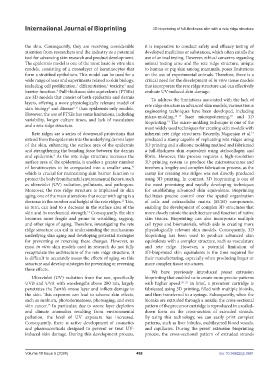Page 496 - IJB-10-5
P. 496
International Journal of Bioprinting 3D bioprinting of full-thickness skin with a rete ridge structure
the skin. Consequently, they are receiving considerable it is imperative to conduct safety and efficacy testing of
attention from researchers and the industry as a potential developed medicines or substances, which often entails the
tool for advancing skin research and product development. use of animal testing. However, ethical concerns regarding
The epidermis model is one of the most basic in vitro skin animal testing arise and the rete ridge structure, unique
models, consisting of a monolayer of keratinocytes that to human or pig skin among mammals, poses limitations
form a stratified epithelium. This model can be used for a on the use of experimental animals. Therefore, there is a
wide range of tests and experiments related to skin biology, critical need for the development of in vitro tissue models
including cell proliferation, differentiation, toxicity, and that incorporate the rete ridge structure and can effectively
1
2
3
barrier function. Full-thickness skin equivalents (FTSEs) evaluate UV-induced skin damage.
4
are 3D models that consist of both epidermis and dermis To address the limitations associated with the lack of
layers, offering a more physiologically relevant model of rete ridge structure in advanced skin models, various tissue
skin biology and disease than epidermis-only models. engineering techniques have been developed, including
6–8
5
However, the use of FTSEs has some limitations, including micro-molding, 14–17 laser micropatterning, and 3D
18
variability, longer culture times, and lack of vasculature bioprinting. The micro-molding technique is one of the
19
and a rete ridge structure. most widely used techniques for creating skin models with
Rete ridges are a series of downward projections that inherent rete ridge structures. Recently, Nagarajan et al.
14
extend from the epidermis into the underlying dermis layer produced a stamp capable of replicating rete ridges using
of the skin, enhancing the surface area of the epidermis 3D printing and a silicone molding method and fabricated
and strengthening the bonding force between the dermis a full-thickness skin equivalent using atelocollagen and
and epidermis. As the rete ridge structure increases the fibrin. However, this process requires a high-resolution
9
surface area of the epidermis, it enables a greater number 3D printing system to produce the microstructures and
of keratinocytes to be compacted into a smaller area, involves a lengthy and complex fabrication process, as the
10
which is crucial for maintaining skin barrier function to stamp for creating rete ridges was not directly produced
protect the body from harmful environmental factors, such using 3D printing. In contrast, 3D bioprinting is one of
as ultraviolet (UV) radiation, pollutants, and pathogens. the most promising and rapidly developing techniques
Moreover, the rete ridge structure is implicated in skin for establishing advanced skin equivalents. Bioprinting
aging; one of the main alterations that occur with aging is a facilitates precise control over the spatial organization
decrease in the number and height of the rete ridges. This, of cells and extracellular matrix (ECM) components,
11
in turn, can lead to a decrease in the surface area of the enabling the development of complex 3D structures that
skin and its mechanical strength. Consequently, the skin more closely mimic the architecture and function of native
12
becomes more fragile and prone to wrinkling, sagging, skin tissues. Bioprinting can also incorporate multiple
and other signs of aging. Therefore, investigating the rete cell types and biomaterials, which aids in creating more
ridge structure can aid in understanding the mechanisms physiologically relevant skin models. Consequently, 3D
underlying skin aging and developing potential strategies bioprinting has been used to produce advanced skin
for preventing or reversing these changes. However, as equivalents with a complex structure, such as vasculature
most in vitro skin models used in research do not fully and rete ridge. However, a potential limitation of
recapitulate the architecture of the rete ridge structure, it 3D-bioprinted skin equivalents is the time required for
is difficult to accurately assess the effects of aging on this their manufacturing, especially when producing larger or
structure and develop strategies for preventing or reversing more complex tissue structures.
these effects. We have previously introduced preset extrusion
Ultraviolet (UV) radiation from the sun, specifically bioprinting that enabled us to create more precise patterns
UVB and UVA with wavelengths above 280 nm, largely with higher speed. 20–23 In brief, a precursor cartridge is
penetrates the Earth’s ozone layer and inflicts damage to fabricated using 3D printing, filled with multiple bioinks,
the skin. This exposure can lead to adverse skin effects, and then transferred to a syringe. Subsequently, when the
such as sunburn, photodermatoses, photoaging, and even bioinks are extruded through a nozzle, the cross-sectional
skin cancer. In particular, due to ozone layer depletion pattern of the precursor cartridge is reproduced in a scaled-
13
and climate anomalies resulting from environmental down form on the cross-section of extruded strands.
pollution, the level of UV exposure has increased. By using this technology, we can easily print complex
Consequently, there is active development of cosmetics patterns, such as liver lobules, multilayered blood vessels,
and pharmaceuticals designed to prevent or treat UV- and capillaries. During the preset extrusion bioprinting
induced skin damage. During this development process, process, the cross-sectional pattern of extruded strands
Volume 10 Issue 5 (2024) 488 doi: 10.36922/ijb.3961

